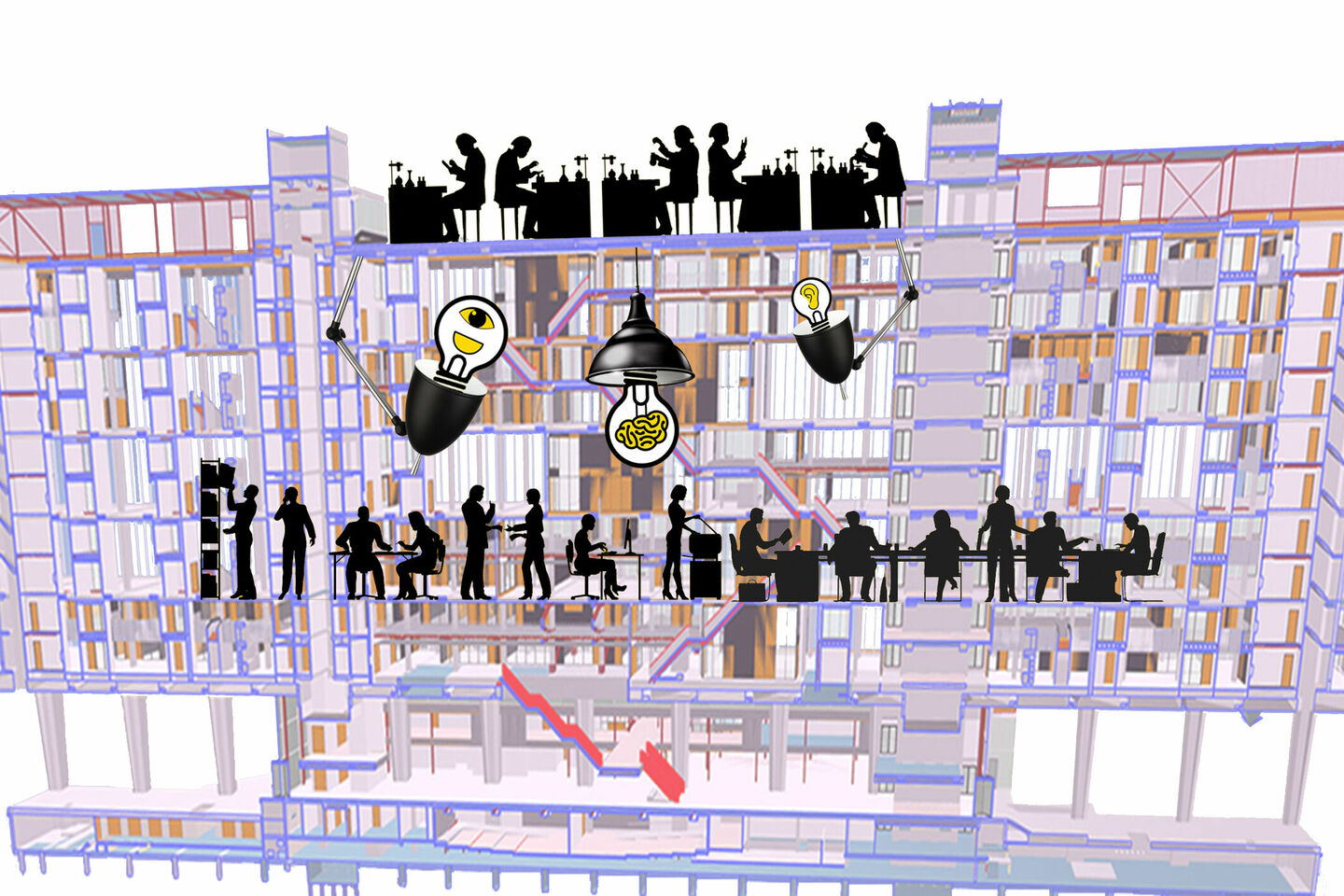
Atlas mustn't become an experimental maze
Staking their life on it would be going a little too far, but the initiators are pretty sure that TU/e's Atlas building could very well become the largest indoor living lab in Europe. Eight floors of the renovated building are not only providing the daily workspace of many hundreds of students and employees, soon they will also become the stage for the Atlas Living Lab. Experiment under conditions as natural as possible without making unwitting guinea pigs of the building's occupants; that is what researchers can do in Atlas as of this spring. But not just anyone.
Indoor and outdoor testing grounds for innovation - this is perhaps the best way to describe ‘living labs’. And these labs, in which typically people's interactions with technology are observed, are certainly not a new phenomenon at TU/e. Research into the effect of light on people's behavior, for example, has been conducted for years at the Intelligent Lighting Institute, Academic Director Ingrid Heynderickx explains. “The contexts vary enormously. How can you light an environment in an energy-saving way that still enables people to feel safe? How can you ensure that people get enough light early in the morning to set their diurnal rhythm? And this: how can you use lighting to lead people outdoors, quickly and along a certain route, in the event of a calamity?”
Such research is done partly - and usually initially - under controlled conditions, but nevertheless in settings that are as natural as possible - so that the behavior of test subjects is influenced as little as possible by the thought of participating in an experiment. The market hall at MetaForum is a living lab, as is (off campus) the Stratumseind in Eindhoven, where research is done on the effect of light on the social ambiance and thus on the behavior of people enjoying a night out on the town.
Value
According to Heynderickx, TU/e's Executive Board likewise saw early on the value of such living labs, including on its own campus - certainly in combination with the planned renovation of some of its large buildings, due to which the utilities such as lighting and climate would be entirely renewed, leaving the way clear for making the new infrastructure intelligent. Elke den Ouden, who has strategic responsibility for TU/e’s living lab, says that earlier in the run-up to Flux a ‘dual role’ as living lab had already been considered for that new build, “but by then the phase for making major decisions had passed. After that we started discussions with Real Estate Management about the Main building (now Atlas, ed.)”.
At that time Atlas was still in “the ambition phase”, explains Philip Ross, project leader of the Atlas Living Lab and owner of the design studio of the same name. “An architect hadn't even been appointed.” Not only did this offer great opportunities (perfectly in tune moreover with TU/e’s credo Where Innovation Starts), it presented major challenges. After all, by way of an example, how do you deal with the data collected vis-à-vis the people who have generated this data during an experiment, perhaps unawares - especially at a time when privacy is a hot topic?
A normally functioning building and a living lab cannot be regarded as two separate entities and placed side by side
This was partly why a working group was set up, says Ross, at a very early stage of preparations for the renovation. Its members represented, among other bodies, the Intelligent Lighting Institute, Real Estate Management, Information Management and Services and the design team RSVP. “A normally functioning building and a living lab cannot be regarded as two separate entities and placed side by side. Meticulous harmonization is called for. That became a lengthy process lasting four-and-a-half years.”
The result is not only a highly acclaimed hypermodern building that scores well in the sustainability rankings, but also “simply a very large lab where research happens”, as Ingrid Heynderickx describes the Atlas Living Lab in a nutshell. “We are uniting different functions in one and the same space.”
The lab extends from floor 4 through to floor 11; at the heart of the technical infrastructure here lies a 'connected office' light system produced by Signify, a combination of smart energy-saving LED luminaires (each with its own IP address) and sophisticated minisensors and detectors that record movements. If extra sensors, for example, are needed for experiments, they can be added, with the necessary approval.
Ethics Committee
To gain this approval researchers must be clear-minded and well-organized ahead of time; the doors of Atlas are certainly not thrown open for just any experiment. Every research proposal - short-term or lengthy, small scale or, for example, spread over multiple floors, originating in-house or from external parties - is put through a process in which TU/e's Ethics Committee assesses and weighs up each individual aspect. Furthermore, in agreement with lab coordinator Nasir Abed, steps are taken to ensure that studies do not overlap or influence one another.
What does a person want to do, for what purpose and for how long? And are all the floors involved, or could only one wing be used?
Den Ouden: “First of all, a research proposal is discussed. What does this person want to do, for what purpose and for how long? And are all the floors involved, or could only one wing be used? What does this person plan to publish and what not?” Moreover, every research study must have a certain relevance to TU/e and any ‘strain’ that might be put on people in the building must be worth it. Or, as Heynderickx puts it jovially: “We don't want to become an experimental maze”.
Some experiments will be more intrusive than others. “You could, say, look at which light settings people habitually use at their work station; that in itself is information, but has little impact on staff. Alternatively, as part of a study of seasonal affective disorder you might want to track a number of people over several years; that, for example, is not something you can do across the whole of floors 4 and 5.”
First and foremost, the building occupants (both students and employees) will always be informed shortly in advance of an experiment - individually or as a group, depending in part on the nature and extent of the planned research. Furthermore, especially where some degree of disruption to their everyday work may be expected, they always have the choice whether or not to participate - likewise the opportunity to, say, work temporarily in another wing or on another floor, where no experiment is running. Philip Ross: “It is and will continue to be a matter of seeking agreement. If an employee or group is approaching an important deadline, it could be that an experiment has to wait.”
Avoidance
Valuable input regarding this was also provided by the feedback round the initiators held with the University Council, the Services Council, the Departmental Councils, trade unions, and others. Ross: “Even though we had done our homework and spoken to ethicists and lawyers, this round still managed to result in some changes being made to the agreements. We were keen to try and tackle any objections that might arise as best we could in advance. The limitation on the physical space involved is a particularly important point. For example, if we want to do an experiment somewhere, a nearby space must be kept available at all times, giving people the option of moving away if they don't wish to participate.”
Another aspect that was (and still is) given plenty of attention is the policy governing the data collected - with the European privacy law (AVG), the Netherlands Code of Conduct for Research Integrity and the TU/e Code of Scientific Conduct providing the framework. For example, it has been established that everyone who may be involved will be informed in advance of the purpose of the research and exactly which data will be collected. “This applies to all experiments. In the case of, say, an evacuation you can hardly ask everyone's permission individually, but a clear statement will at least be made, along the lines of: ‘An experiment will take place today on this floor; if you don't wish to be involved, you may use the other zones not involved in the experiment,’” says Heynderickx.
Come what may, no data will be collected without students and employees being notified in advance, and in principle no data (not even combined data) will be traceable to a particular individual - unless he or she has expressly consented to this. “Nor will we browse through data that is being continuously gathered on another server for the purposes of managing the building. The entire process, including opt-ins and opt-outs, has been put in place precisely so that people know what is happening,” Ross emphasizes.
Heynderickx is aware that it is particularly important that employees of the support services are properly informed about the data handling. “This type of research is sometimes conducted at the two departments here (Industrial Design and Industrial Engineering & Innovation Sciences, ed.) and our staff are fairly familiar with it. With the TU/e services, we are noticing that we need to invest a little more time and effort in this respect.”
Den Ouden is keen to point out that at the end of the day every research study must seek “to improve the quality of life here”; seek to better understand the various needs of different individuals and to provide a work environment in which people feel comfortable and safe and can perform optimally - combined with finding sustainable solutions to everyday problems. “We aren't going to explore the lower limits and see how far we can go before everyone runs away screaming. But we will ask something like this: can we lower the temperature a little and still create a feeling of warmth by giving the light a different tint?”
Transparency about results
This is one reason, says the researcher, why it is considered important that findings are shared with the people in the building. “We are part of an academic community, so people here tend to be interested in research results of this kind anyway. Communication on this topic must be transparent.” Not that all the raw research data will be dumped on the internet, Heynderickx hastens to add, “but to a certain extent we will most definitely disseminate the results, but without it being possible to trace them back to individual persons.”
“Much of the criticism voiced about living labs is that much of the data collected never gets used,” adds Marc Rosmalen, involved in communication about the Atlas Living Lab. “We have taken that to heart here. We aren't doing research with a view to keeping the results under wraps, rather we want to make as much use as possible of all the knowledge we gain. We want maximum openness about what we are doing here.” Whenever a company or other university shows interest in certain data collected in Atlas, their request will be run past the Ethics Committee. Heynderickx: “What level of data does the inquiring organization need: very general, or data per floor, per room, or for a particular period? And above all, what do they plan to do with it?”
According to the initiators, while much has been agreed, discussed and established in advance, nothing is set in stone. Den Ouden: “If people have other ideas about how various things should be done, we'd be happy to start a constructive discussion. We have a population here of very critically minded people, but these are also people who very much interested in what you can do with a living lab like this one, and how you can develop best practice. In the process of using the lab we are bound to encounter unforeseen events and improvements will no doubt be made.”
As is so often the case, finding a good balance is key, says Den Ouden. “We want as many meaningful innovations as possible to come out of this living lab and in that sense we want to make it easily available to and appealing to researchers wishing to do experiments here - including, for example, final year students or student teams. But this must be approached very carefully.”
No typical lab
The Atlas Living Lab will have the same status as other TU/e laboratories and will be the fifteenth of the university's larger labs, with a detailed descriptions of its objectives and facilities posted on the TU/e website. The cost involved in realizing the lab is a topic on which the initiators admit they find it hard to comment - partly because, in view of the university's aspirations for sustainability, among other things, some of the infrastructure that has been built was already planned. Den Ouden says, “It's not as if you can point out: ‘This is where ordinary lighting stops and where the Atlas Living Lab starts’. It is no typical lab where, say, money has been invested in the purchase of certain machines.”
Ingrid Heynderickx hopes that the first experiment in the Atlas Living Lab will be running before this coming summer. The laboratory will be officially opened on March 21st, at the same time as the festive opening of the renovated building.

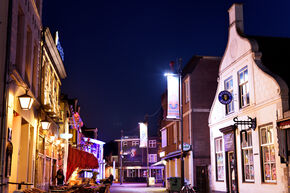
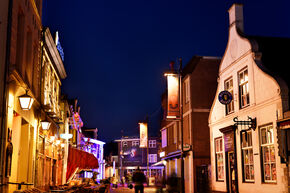
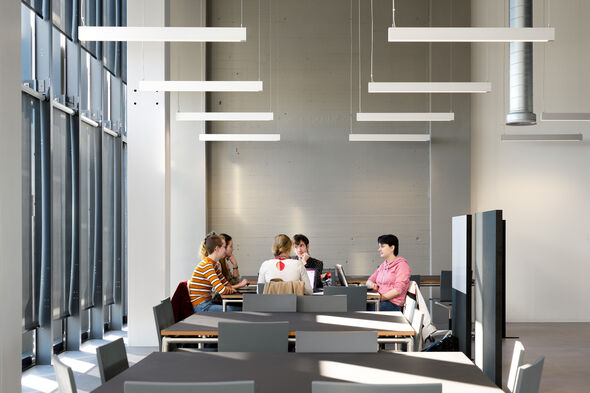
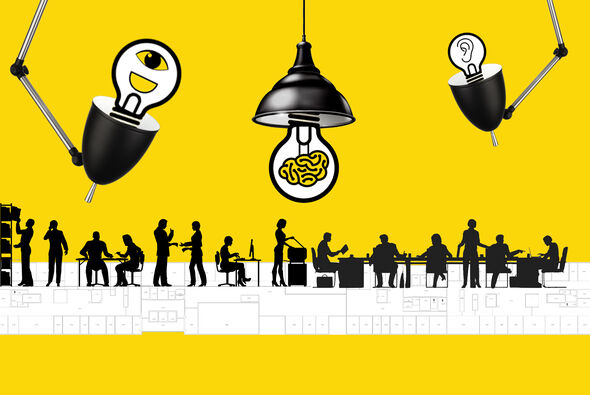
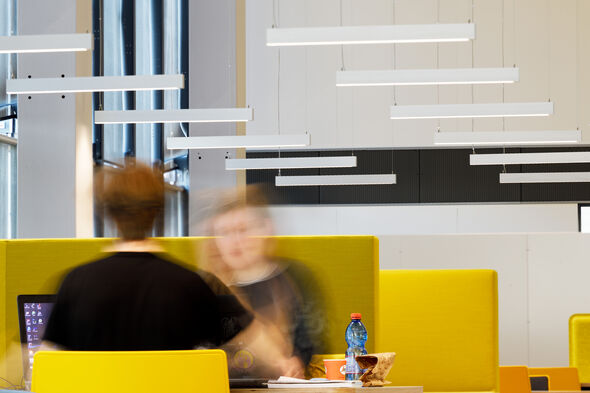
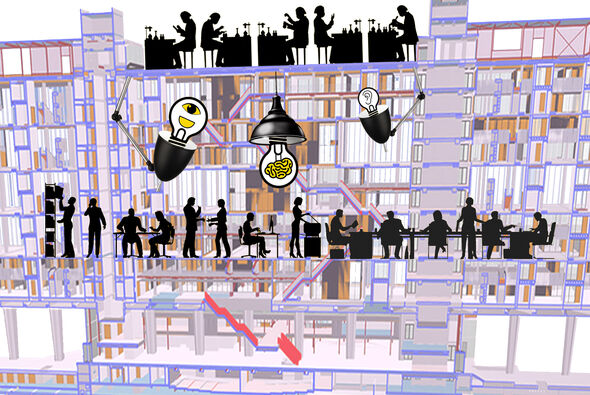
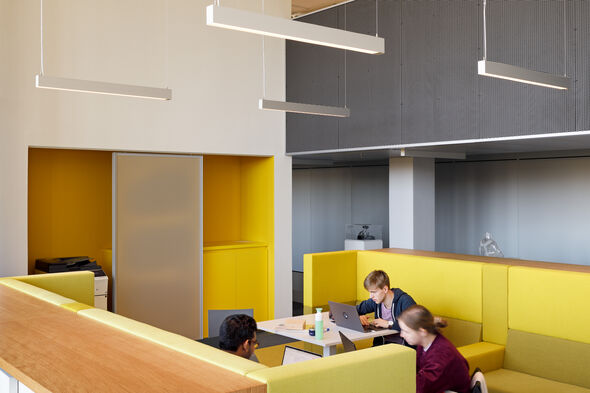
Discussion